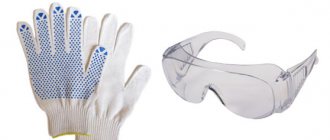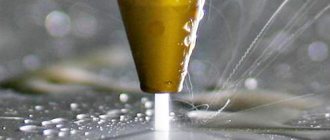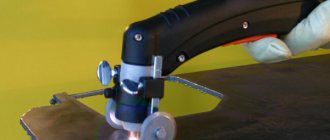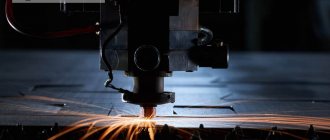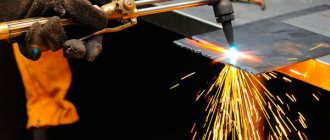Equipment that allows cutting sheet metal is required at any machine-building and metalworking enterprise. Very often, the technical capabilities of the most common types of such equipment are not enough to ensure high quality cuts.
Fluid cutting process
The essence of technology
A metal sheet blank is placed on the work surface. It is cut out according to the required format. The cutting areas are exposed to water with the addition of abrasive particles. These substances interact with the surface, destroying it. In this case, it is necessary to maintain a certain pressure and pressure, which ensures the required flow rate of liquid and solid particles. The task of equipment using this technology is to separate a part from the whole. The power of the device is great, but its capabilities are limited by the density of the alloy and its thickness.
Safety precautions
The waterjet cutting process is not particularly dangerous. The distance from the tube from which the jet comes out to the surface being treated is only 2.5 mm. This eliminates the impact of the jet on the hand. When the water pressure exceeds the permissible limit, a relief valve opens, which reduces the pressure to operating pressure. However, certain safety precautions should be observed when working on machines.
- Do not expose your body to the jet under any circumstances. Such a jet is capable of cutting metal 150 mm thick, let alone a hand. While working, keep your hands as far as possible from the cutting area. Before turning on the machine, make sure there are no foreign objects in the cutting path.
- Protect your eyes and hearing. Be sure to wear safety glasses and earplugs (or headphones).
- Do not place your hands on your desk.
The leaders in the production of waterjet cutting machines are the American companies Jet Edge, Flow, OMAX, and the Italian WaterJet Corp Inc. and Caretta Technology, Dutch Resato, Czech PTV, Swedish Waterjet Sweden, Finnish ALICO, Swiss Bystronic.
Source
The operating principle of waterjet cutting of metal and steel
During the cutting of rolled metal, the following processes occur:
- The engine drives the pump, which creates a water jet - it is supplied to the mixer from the tank.
- On the other hand, at the same time, abrasive of the required quantity and particle diameter is sent.
- The two elements mix to form a relatively homogeneous liquid.
- The high-pressure mixture is directed to the nozzle, which controls the inclination and speed.
- The material comes into contact with the surface of the workpiece, cutting it.
In this case cooling occurs.
Application area
The prevalence of the method is explained by the great capabilities of the device. It can be used on virtually any natural and synthetic materials. This does not apply only to diamond and tempered glass. The peculiarity (and at the same time the demand) is that it is possible to process substances that cannot be heated - they lose or change their physical and chemical properties or are susceptible to easy ignition. And cutting with a jet of water occurs without changing the temperature. Thus, the range of possible work is significantly expanded. Most often metalworking is carried out on:
- stainless steel;
- tool steel;
- aluminum;
- titanium;
- brass.
Granite, marble and other natural and artificial stones are also cut using this method. The use of the machine is possible only in a workshop, established production. The video will show where it is used:
Scope of use
The main difference that water cutting of metal has from other processing methods is that there is no mechanical effect on the surface of the material. The absence of heat and friction of tools affects the possible areas of use and the quality of the cut.
The equipment is used for cutting materials such as:
- ceramics, glass;
- stone, granite, marble;
- rubber, paronite, ebonite and textolite plates, plastic;
- reinforced concrete;
- metals, including: steel, titanium.
Water cutting equipment
They call it “dusty-free.” Indeed, there are virtually no chips, or rather, they are immediately washed away, resulting in a very even and clean cut, which, in most cases, does not even require grinding. The technological process is based on a natural phenomenon of water bodies - erosion, that is, the ability to erode the banks, while grinding away stones and tree roots. The essence remains the same, but in order to speed up the effect many times over, an abrasive is added to the liquid.
This mixture is released with a very high pressure jet. The pressure reaches 6 thousand atmospheres, and a speed develops that is three times higher than the propagation of a sound wave in the air - 800-1000 meters per second. Two main tasks of the equipment:
- separation and washing out of particles of workpiece material;
- instant cooling and cleansing.
The device of a machine that cuts with water
The classic device has many components:
- body - usually consists of metal, as the most wear-resistant and durable material, due to which it is quite massive;
- capacity – large, usually at least two cubic liters, but can be more;
- powerful pump - it performs an important function, pumps up high pressure and directs liquid from the reservoir to the junction of the two components;
- durable hoses - connect all components;
- compartment for storing and supplying abrasive particles;
- mixer;
- tool - it regulates the power of the jet, its width, direction;
- the plane on which the workpiece is located and the work will take place;
- Control block.
Most machines are equipped with CNC; the engineer only controls the process using a remote control, but does not do cutting manually. This is convenient - there is no negative impact on the person operating the machine and at the same time excellent accuracy is achieved. Another advantage of CNC is the ability to use computer-aided design programs, which can be used to create a project in a format compatible with the control unit.
Features of the main components
The uniqueness of the installation lies in many differences, starting with the desktop. Instead of the usual plane, a bathtub with shallow sides is presented here. It is equipped with ribs for gripping and fixing the workpiece; they can be quickly removed and applied. Also, the container is filled with liquid and then drained. The constant presence of metal in an aquatic environment makes it possible to eliminate noise and dust from production. The container, which contains abrasive particles, is easily removed, has a replenishment function even during operation, and is also equipped with sensors that control the amount of mixture.
The tool movement system is very important. It is mounted on belts that move the cutter along linear planes. Straps are used rather than chains, as they are more resistant to moisture, as well as to accidental ingress of abrasives. An additional advantage is that they are easy to replace when worn. Let's look at the video for more details about the device:
About the design features
To achieve the required result, industry uses exclusively CNC machines. Therefore, the process is almost completely controlled by electronics. A professional machine includes various systems. For example, controlling the optimal clearance. This system provides the best distance between the cutting head and the metal being processed for the greatest accuracy in the cut location. A material scanning sensor is also used. It is needed to scan the metal for irregularities. The readings are transmitted to the CNC, as a result of which the gap changes.
To automate the process, an abrasive supply control sensor is introduced into the system. It regulates the amount of pomegranate sand. In addition, such a system stops operation if foreign elements (burlap, coarse particles) enter the high-pressure pump. All this must work as one, and only in this situation can optimal results be achieved. A modern industrial machine costs a lot of money and therefore requires regular maintenance. If this is not done, it may fail completely.
Possibilities of water-based metal cutting
Many methods are used only for direct sawing, while water cutting allows:
- make a curly cut;
- do not process edges;
- process sheets (metal blanks) up to 120 – 200 mm thick, depending on the type of steel;
- connect a difficult project to an automatic control panel and actually not participate in the process, only control it;
- cut circles, pipes.
Nowadays the technology is actively used in various fields:
- automotive and mechanical engineering in general;
- production of blanks and parts that cannot be stamped;
- water cutting of iron, insulation, fiberglass, insulators, marble;
- artistic processing.
How to strengthen a concrete opening
After you have cut out the opening or expanded it, you need to reinforce the walls with additional metal structures.
Strengthening openings can be as follows:
- Single row. To construct this type of fortification, a channel is used. You need to make a U-shaped frame around the opening. In this design, various types of channels are used, and fastening to the walls can be done in various ways. Places where the channel does not adhere to the wall must be filled with mortar.
- Ugolkov. Edging is done with corners on both sides of the wall. To fasten the corners to each other, pins and metal plates are used. These are the most common designs.
- Combined. The openings are strengthened using channels and corners.
Control
For efficient operation of the machine, the work of several engineers and operators is required. The designer is required to create the project in a special computer environment. The file is then placed in the device memory. The machine itself distributes functions to other nodes. The employee is responsible for ensuring that there is a sufficient supply of consumables, for launching the program, monitoring its implementation, and providing timely notification of breakdowns. The equipment specialist is required to carry out technical inspection (preventive) and also troubleshoot problems.
CNC waterjet machines
Numerical control allows the most difficult parts to be produced with an error of half a millimeter. The production process is fully automated, it does not require constant commands, it only needs to set the program once (select from a list or enter into memory) and start it. Such equipment is expensive, but more efficient. There is no human factor, that is, the risk of errors is minimized.
How to cut metal by hand with water
Less popular in production, but theoretically possible for production at home. The operator’s task is to select the cutting angle, pressure, pressure and jet width. It is more difficult to work with, but once learned, a specialist will be able to make simple forms very productively. The accuracy remains high, but the feature set is relatively small. Another advantage is that the price is significantly lower than that of CNC equipment.
Consumables
The main raw material is pure water and abrasive particles that have gone through multi-stage filtration so that there are no impurities that can react with the workpiece. The consumption is quite large, and the thicker the alloy, the more consumables are used per second. The most inexpensive abrasive is fine sand. Sand grains measuring about 650 microns effectively cope even with refractory, high-strength alloys. At the same time, they have an affordable price. It is also regularly necessary to replace spare parts - tubes and hoses, seals. Less often - the motor, tanks, nozzles.
What pressure is needed to cut metal with water?
The minimum pressure is 1500 atmospheres, the maximum is 6000. The indicator is adjusted depending on the density of the steel and the required operating speed. You can do this manually or trust the smart control unit.
Advantages of a water jet machine
Now this is one of the most effective and popular methods, due to its advantages:
- this is the “coldest” method of metalworking, which allows you to work even with substances whose physical and chemical properties change due to heat;
- low material loss - there are virtually no chips, the cut is smooth and narrow;
- good for thin sheets, but it is also possible with denser ones - up to 3 cm;
- there is no need for final sanding, the edges are very smooth;
- highest accuracy – 0.5 mm;
- you can cut out any difficult parts;
- it is possible to cut in a “package”, that is, in several layers at once, if the workpieces are thin enough;
- very high cleanliness of work - no dust, noise, gases;
- fire safety is complete;
- the absence of a sharp cutting tool, that is, it does not need to be changed or sharpened.
Scissors, but not tailor's ones
As a rule, scissors in everyday perception are necessarily associated with cutting fabric, paper, leather and other materials that are not particularly durable. What do you think of the option called hydraulic shears for reinforced concrete? Believe me, there are such people.
With all its aggressive appearance and undisguised power, hydraulic shears are very reminiscent of a fossil lizard - a tyrannosaurus
Crusher and cruncher: brothers, but not twins
Hydraulic shears are one of the many tools that are equipped with excavators, usually crawler ones. The working mechanism is made in the form of a pair of cheeks made of high-alloy tool steel, which move according to a given algorithm using hydraulic cylinder rods powered by a standard high-pressure hydraulic system.
Hydraulic shears from serious manufacturers are mounted on a rotator head, which allows the working body to rotate around its axis.
A hydraulic rotator is an extremely useful thing that allows the scissors not only to rotate relative to the axis, but also to rotate around it
Hydraulic shears are a quick-release mechanism, and modern models are designed and made in such a way that they can be installed and removed by one person - the excavator operator, and he directly connects only the hydraulic system connectors with his own hands.
The operator's instructions are designed in such a way that they repeat the working algorithms for the movement of the boom and bucket of an excavator during basic and most common work and therefore can be easily mastered by even low-skilled excavator operators, who make up the bulk of the domestic labor market.
Protecting the cabin of an excavator equipped with hydraulic shears is absolutely necessary to protect not only the glazing, but also the operator himself from fragments of destructible concrete
The cost of such systems is high, primarily because effective mechanisms are manufactured exclusively by American, European and Japanese manufacturers. Chinese and domestic developments are extremely ineffective and short-lived, and, in essence, are low-quality copies of well-established brands.
For rough destruction of reinforced concrete structures, a crusher is used - its working body has more massive and larger teeth and larger gripping cavities.
The Swedes have released an excavator designed specifically for dismantling large structures, equipped not only with an extra-long boom, but also with a lifting cabin
A cruncher is used to crush dismantled concrete fragments. After processing pieces of concrete with its jaws, the resulting mass can be used as crushed concrete when organizing cushions, arranging temporary roads, filling sites and other activities.
The secondary crushed stone obtained in this way has a fraction of 40-70 mm convenient for clinching crushed stone cushions
You can learn more about the basics of waterjet cutting of concrete and examples of dismantling concrete structures using a hydraulic wedge and hydraulic shears by watching the video in this article.
Water cutting price
The cost of such equipment, as well as its maintenance, is high. It is for this reason that the method is used mainly in large industries - where all costs are compensated by a high-quality final product. The price tag adds up:
- from a powerful pump;
- expensive CNC system;
- Artificial diamond nozzles.
In the article we told how to cut metal with water, and also showed examples of machines that cut using a water jet. To finish, we recommend watching a few videos:
Contact Rosta LLC if you decide to buy devices for industrial use. We have manual and semi-automatic band saws in stock and on order, as well as pendulum, vertical and two-post units. The price of goods has been reduced by 1.5 - 2 times compared to foreign analogues. To clarify the information you are interested in, contact our managers, we will be happy to help you select equipment.
How wall thickness affects concrete cutting
The size of the wall thickness is the main indicator by which it is determined which cutting method to use.
- The grinder can cope with a slot depth not exceeding 10 cm.
- With a concrete slab thickness of 8-10 cm, a machine with increased power is required for operation.
- When the thickness of the concrete slab is 15-16 cm, a circular saw is used, the diameter of the discs should be 350-400 mm. If you use a grinder, the work will have to be carried out in several stages, and the tool may overheat and break.
- If the concrete is 30 cm thick or more, use a special wall cutting tool - manual or machine.
- Concrete, the thickness of which reaches 60 mm, is cut using a tool such as a chain saw, a ring cutter.
- A concrete slab whose thickness exceeds 60 cm is cut with special equipment. A disc with a diameter of 100 mm or more is used. Rope cutting devices can also be used.



